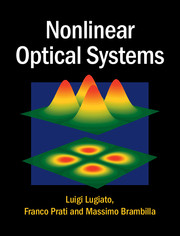Book contents
- Frontmatter
- Dedication
- Contents
- Preface
- Part I Models, propagation, stationary phenomena
- Part II Dynamical Phenomena, Instabilities, Chaos
- Part III Transverse optical patterns
- 26 Gaussian beams and modes of cavities with spherical mirrors
- 27 General features about optical pattern formation in planar cavities
- 28 The Lugiato-Lefever model
- 29 Spatial patterns in cavities with spherical mirrors
- 30 Cavity solitons
- Appendix A The Routh–Hurwitz stability criterion
- Appendix B Calculation of the oscillatory instability boundary
- Appendix C Coefficients of the characteristic equation (20.20)
- Appendix D Derivation of equations (20.27) and (20.28)
- Appendix E Coefficients of equations (20.60) and (20.61)
- Appendix F The exact boundary of the Risken–Nummedal–Graham–Haken instability
- Appendix G Nonlinear analysis of the roll solution
- References
- Index
30 - Cavity solitons
from Part III - Transverse optical patterns
Published online by Cambridge University Press: 05 March 2015
- Frontmatter
- Dedication
- Contents
- Preface
- Part I Models, propagation, stationary phenomena
- Part II Dynamical Phenomena, Instabilities, Chaos
- Part III Transverse optical patterns
- 26 Gaussian beams and modes of cavities with spherical mirrors
- 27 General features about optical pattern formation in planar cavities
- 28 The Lugiato-Lefever model
- 29 Spatial patterns in cavities with spherical mirrors
- 30 Cavity solitons
- Appendix A The Routh–Hurwitz stability criterion
- Appendix B Calculation of the oscillatory instability boundary
- Appendix C Coefficients of the characteristic equation (20.20)
- Appendix D Derivation of equations (20.27) and (20.28)
- Appendix E Coefficients of equations (20.60) and (20.61)
- Appendix F The exact boundary of the Risken–Nummedal–Graham–Haken instability
- Appendix G Nonlinear analysis of the roll solution
- References
- Index
Summary
With respect to the goal of encoding information in transverse spatial structures, patterns arising from combinations of a few modes present an intrinsic limitation, because their various parts are strongly correlated with one another. Therefore any local modification induced by an external control in order to encode information affects also other parts of the pattern, or, alternatively, the correlation leads to spontaneous elimination of the modification itself. For example, one might consider a lattice of intensity peaks that arise in the near field from the superposition of a few plane waves generated by a spatial instability as described in Section 27.2 (see Fig. 30.1(a), in which we consider a square lattice). If the peaks were independent of one another, they could be addressed individually as pixels and one could encode information in binary form (Fig. 30.1(b)). However, this is made impossible by the strong correlation between the points in the lattice. In the opposite case of many modes, one opens the door to the world of complexity. However, one must avoid having the behavior of the system become irregular, hence it is necessary to introduce control. In order to ensure the possibility of a reasonably practical implementation, the control procedure must be simple.
One finds that by generating solitons in a nonlinear cavity (cavity solitons) one can realize a set of intensity peaks that can be addressed (i.e. written and erased) individually and pinned down to precise locations, so that one is indeed dealing with an array of independent pixels as in Fig. 30.1(b). A set of N × N solitons constitutes a memory (or, in general, an optical processor) with 2N × N distinct states. This approach was pioneered by the work of Rosanov (see [390–392] and references cited therein) on “diffractive autosolitons” and of Moloney and collaborators [393]. In [390–392] autosolitons arise from the interaction of switching waves connecting two homogeneous stationary states.
- Type
- Chapter
- Information
- Nonlinear Optical Systems , pp. 393 - 411Publisher: Cambridge University PressPrint publication year: 2015



